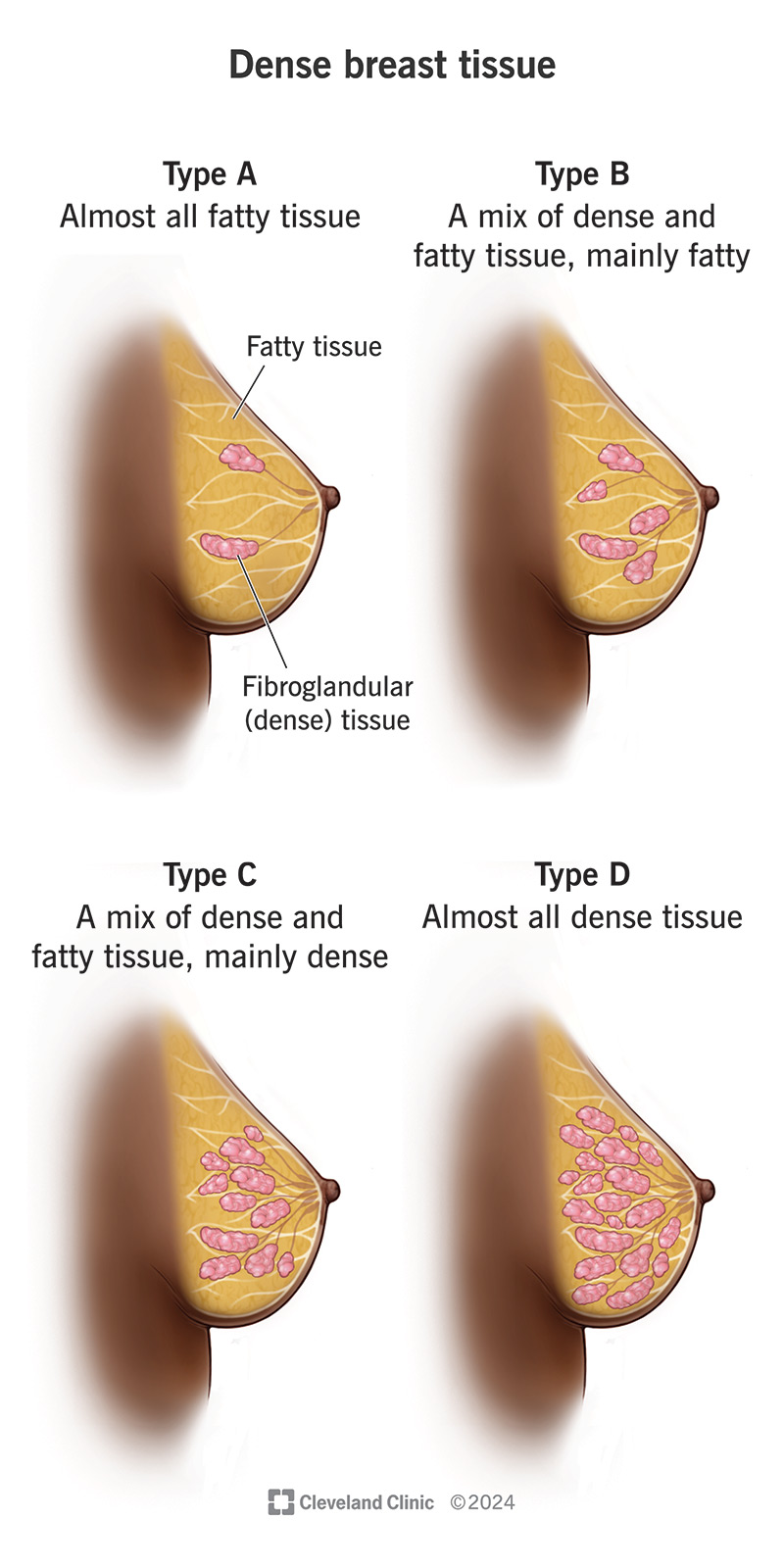Dense breast tissue refers to the way breast tissue appears on a mammogram. It’s normal and common to have dense breast tissue. But having lots of dense tissue may increase your breast cancer risk. If you have dense breast tissue, a healthcare provider may recommend additional breast cancer screening tests.
Advertisement
Cleveland Clinic is a non-profit academic medical center. Advertising on our site helps support our mission. We do not endorse non-Cleveland Clinic products or services. Policy

Dense breast tissue is when your breasts have more fibrous and glandular tissue and less fatty tissue. It’s common — about 50% of females have dense breast tissue.
Advertisement
Cleveland Clinic is a non-profit academic medical center. Advertising on our site helps support our mission. We do not endorse non-Cleveland Clinic products or services. Policy
Dense breast tissue doesn’t cause symptoms. It doesn’t make your breasts hurt or change what they look like. You won’t feel any change in your breasts when you do a self-breast examination, or a healthcare provider checks your breasts.
Providers don’t do tests to diagnose dense breast tissue. Typically, you learn you have dense breast tissue if you have a 3D mammogram (digital breast tomosynthesis). Your mammogram report will state if your breast tissue is dense or not dense.
Dense breast tissue makes it more difficult for a radiologist to detect breast cancer because both tumors and dense breast tissue appear white on a mammogram. You may have higher risk of developing breast cancer if you have extremely dense breast tissue.
Learning that your breast tissue is denser than is typical may surprise you. Having dense breast tissue isn’t a cause for alarm. But it is a reason to ask a healthcare provider to explain your mammogram results. They may use terms like breast density or fibroglandular density when they talk about dense breast tissue.
To understand dense breast tissue, it may help to know more about your breast tissues. There are three types of breast tissue:
Advertisement
Radiologists use the Breast Imaging Reporting and Data System (BI-RAD) to classify dense breast tissue. This data system puts breast tissue into four categories. The categories range from having very little dense tissue to having extremely dense tissue. The four categories are:
| Rank | Classification | Description | Prevalence |
|---|---|---|---|
| A | Mostly fatty tissue. | Breast tissue is almost all fat. | About 10%. |
| B | Scattered fibroglandular breast tissue. | A mix of dense and fatty tissue, but mostly fatty. | About 40%. |
| C | Heterogeneously dense breast tissue. | A mix of dense and fatty tissue, but mostly dense. | About 40%. |
| D | Extremely dense breast tissue. | Breast tissue is almost all dense. | About 10%. |
| Rank | |||
| A | |||
| Classification | |||
| Mostly fatty tissue. | |||
| Description | |||
| Breast tissue is almost all fat. | |||
| Prevalence | |||
| About 10%. | |||
| B | |||
| Classification | |||
| Scattered fibroglandular breast tissue. | |||
| Description | |||
| A mix of dense and fatty tissue, but mostly fatty. | |||
| Prevalence | |||
| About 40%. | |||
| C | |||
| Classification | |||
| Heterogeneously dense breast tissue. | |||
| Description | |||
| A mix of dense and fatty tissue, but mostly dense. | |||
| Prevalence | |||
| About 40%. | |||
| D | |||
| Classification | |||
| Extremely dense breast tissue. | |||
| Description | |||
| Breast tissue is almost all dense. | |||
| Prevalence | |||
| About 10%. |
There’s no single cause for dense breast tissue. Risk factors include your:
There isn’t a medication or procedure to reduce the amount of fibrous and fibroglandular tissue in your breasts.
If a mammogram shows you have dense breast tissue, a healthcare provider may do a breast cancer risk assessment. This tool predicts the likelihood that you’ll have breast cancer during your lifetime
Your provider may use assessment results and your mammogram results to order additional imaging tests, including:
No, it can’t. Breast cancer happens when breast cells mutate and become cancerous cells. That can happen if your breasts are fatty or dense. But having extremely dense breast tissue increases your breast cancer risk. That’s because breast cancer often starts in your fibroglandular tissue, a type of dense breast tissue. The more fibroglandular tissue that you have in your breast, the greater the chance you’ll develop breast cancer.
You’ll likely learn you have dense breast tissue from your mammogram results. Dense breast tissue is common and isn’t a serious medical issue. But dense breast tissue may increase the chance that routine mammograms don’t show signs of cancer. You can’t remove dense breast tissue. Regular mammograms and self-examinations may increase the chance of detecting breast cancer early when it’s easier to treat.
Advertisement
A mammogram is a way to keep track of changes in your breasts. Cleveland Clinic’s experts can help you get a mammogram and connect you to the care you need.

Last reviewed on 11/01/2024.
Learn more about the Health Library and our editorial process.